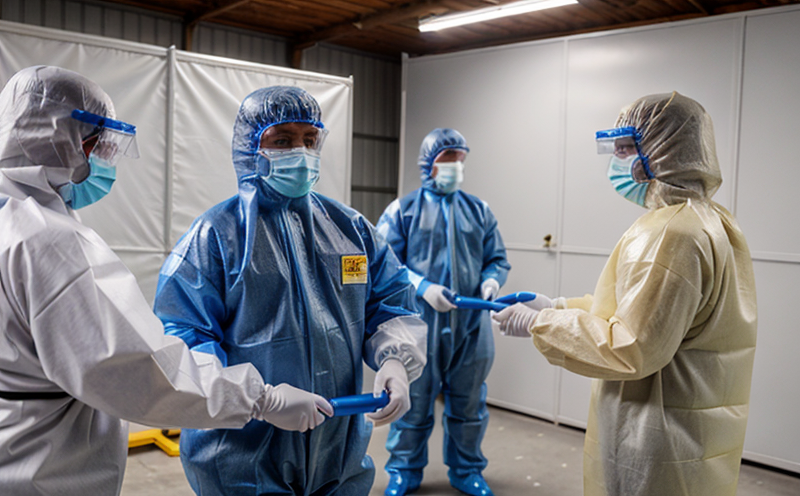JIS T8115 Chemical resistant protective garments Test method
The JIS (Japanese Industrial Standards) T8115 specifies a standardized test procedure aimed at evaluating the chemical resistance of protective clothing designed to safeguard workers from contact with chemicals. This test is crucial in ensuring that the protective garments meet rigorous safety standards and provide adequate protection for end-users.
Protective clothing testing, particularly under JIS T8115, involves exposing samples of fabric to a series of chemical agents that simulate real-world exposure scenarios. The primary goal is to determine the garment's resistance to penetration by these chemicals, thereby assessing its effectiveness in preventing harmful contact with the wearer.
The testing process typically includes several key steps: specimen preparation, conditioning, and conditioning of the test solution, as well as the actual exposure procedure. Specimens are cut into specific dimensions based on predefined standards, conditioned under controlled environmental conditions, and then exposed to a series of chemicals. The chemicals used in this test can vary widely depending on the intended use of the protective clothing.
The acceptance criteria for JIS T8115 are stringent, designed to ensure that only garments capable of withstanding high levels of chemical resistance pass the test. These criteria include specific time limits and concentration ranges for the chemicals used in testing. Passing this test not only ensures compliance with national safety standards but also enhances consumer confidence in the product.
The importance of JIS T8115 goes beyond mere regulatory compliance; it plays a pivotal role in safeguarding workers' health and safety by providing them with garments that can effectively resist chemical hazards. This is particularly important for industries such as manufacturing, laboratory work, and emergency services where exposure to chemicals is common.
Understanding the nuances of JIS T8115 helps quality managers, compliance officers, R&D engineers, and procurement teams make informed decisions about which protective clothing products meet the necessary safety standards. By adhering to these stringent testing protocols, manufacturers can ensure that their products are reliable and effective in protecting workers from chemical hazards.
In conclusion, JIS T8115 is a vital standard for assessing the chemical resistance of protective garments. It provides a framework for ensuring that protective clothing meets rigorous safety standards, thereby safeguarding worker health and enhancing overall workplace safety.
Applied Standards
| Standard | Description |
|---|---|
| JIS T8115 | Japanese Industrial Standard specifying the test method for chemical resistance of protective clothing. |
| ASTM F739-06 | American Society for Testing and Materials standard for determining permeability to liquids by diffusive flow through protective clothing. |
| EN ISO 16712:2015 | European Standard for chemical protective gloves, which can complement the testing of garments under JIS T8115. |
| ISO/TR 13999-1 | International Organization for Standardization technical report on personal protection equipment in general. |
Why Choose This Test
The JIS T8115 chemical resistant protective garments test method is a critical component of ensuring the safety and effectiveness of protective clothing. By adhering to this standard, manufacturers can produce garments that not only meet regulatory requirements but also provide reliable protection against chemical hazards.
One of the primary reasons for choosing JIS T8115 testing is its stringent acceptance criteria. These criteria ensure that only garments capable of withstanding high levels of chemical resistance pass the test. This level of rigor helps maintain a high standard of safety and reliability in protective clothing, which is essential for industries where worker exposure to chemicals is common.
Another advantage of JIS T8115 testing is its comprehensive approach to evaluating chemical resistance. The test involves exposing samples to a series of chemicals under controlled conditions, simulating real-world exposure scenarios. This allows manufacturers to assess the garment's performance in various chemical environments, providing valuable insights into its effectiveness.
Furthermore, JIS T8115 testing contributes to enhancing consumer confidence in protective clothing products. By ensuring that garments meet rigorous safety standards, this test helps build trust between manufacturers and their customers. This is particularly important for industries where worker safety is paramount, such as manufacturing, laboratory work, and emergency services.
In conclusion, choosing JIS T8115 testing for chemical resistant protective garments offers several benefits, including stringent acceptance criteria, comprehensive evaluation of chemical resistance, and enhanced consumer confidence in the product. These factors make it an essential standard for ensuring the safety and effectiveness of protective clothing.
Competitive Advantage and Market Impact
Adhering to JIS T8115 standards can provide significant competitive advantages for manufacturers of chemical resistant protective garments. By meeting these stringent requirements, companies can differentiate their products in the market, offering a higher level of safety and reliability compared to competitors who may not adhere to such rigorous testing protocols.
Consumer confidence is a key factor in determining market success, especially in industries where worker exposure to chemicals is common. JIS T8115 testing enhances this confidence by ensuring that protective clothing meets the necessary safety standards. This can lead to increased demand for products from manufacturers who comply with these standards.
In addition to consumer trust, adhering to JIS T8115 can also help companies meet regulatory requirements and avoid potential legal issues. Non-compliance with such standards could result in costly penalties or product recalls, which can have a detrimental impact on the company's reputation and financial health.
The market impact of complying with JIS T8115 is profound. It not only enhances safety but also contributes to increased productivity by minimizing downtime due to worker injuries or illnesses caused by chemical exposure. This can result in cost savings for businesses, making JIS T8115 a valuable standard for both manufacturers and end-users.
In conclusion, adhering to JIS T8115 standards provides significant competitive advantages, enhances consumer confidence, meets regulatory requirements, and contributes to increased productivity. These factors make it an essential standard for ensuring the safety and effectiveness of chemical resistant protective garments.





